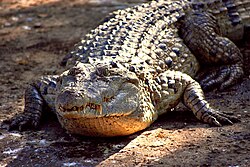Philippine crocodile
| Philippine Crocodile | |
|---|---|
 |
|
| An adult Crocodylus mindorensis basking | |
| Scientific classification | |
| Kingdom: | Animalia |
| Phylum: | Chordata |
| Class: | Reptilia |
| Order: | Crocodilia |
| Family: | Crocodylidae |
| Genus: | Crocodylus |
| Species: | C. mindorensis |
| Binomial name | |
|
Crocodylus mindorensis Schmidt, 1935 |
|
| Range of the Philippine crocodile in blue | |
The Philippine crocodile (Crocodylus mindorensis), also known as the Mindoro crocodile, the Philippine freshwater crocodile or locally, bukarot, is one of two species of crocodiles found in the Philippines; the other is the larger Indo-Pacific crocodile or saltwater crocodile (Crocodylus porosus). The Philippine crocodile, the species endemic only to the country, became data deficient to critically endangered in 2008 from exploitation and unsustainable fishing methods, such as dynamite fishing. Conservation methods are being taken by the Dutch/Filipino Mabuwaya foundation, the Crocodile Conservation Society and the Zoological Institute of HerpaWorld in Mindoro island. It is strictly prohibited to kill a crocodile in the country, and it is punishable by law.
Until 1989, it was considered a subspecies of the New Guinea crocodile (Crocodylus novaeguineae).
The Philippine crocodile is a crocodilian endemic to the Philippines. It is a relatively small, freshwater crocodile. It has a relatively broad snout and thick bony plates on its back (heavy dorsal armor). This is a fairly small species, reaching breeding maturity at 1.5 m (4.9 ft) and 15 kg (33 lb) in both sexes and a maximum size around 3.1 m (10 ft). Females are slightly smaller than males. Philippine crocodiles are golden-brown in color, which darkens as they mature.
The Philippine crocodile has been extirpated in Samar, Jolo, Negros, Masbate, and Busuanga. Populations still survive in the Northern Sierra Madre Natural Park within the Luzon rainforest, San Mariano, Isabela, Dalupiri island in the Babuyan Islands, Abra (province) in Luzon and the Ligawasan Marsh, Lake Sebu in South Cotabato, Pulangi River in Bukidnon, and possibly in the Agusan Marsh Wildlife Sanctuary in Mindanao. It was historically found in parts of Visayas and until the numbers were drastically cut by, mainly, habitat destruction.
...
Wikipedia

